Disclaimer: All Information is given in good faith, but is used entirely at your own risk.
This page describes typical anchor equipment of Boats on the Tidal River Trent – narrowboats and cruisers. It concludes with some contributions on anchoring procedures from five boaters.
Last updated: March 6th 2022.
Narrowboats
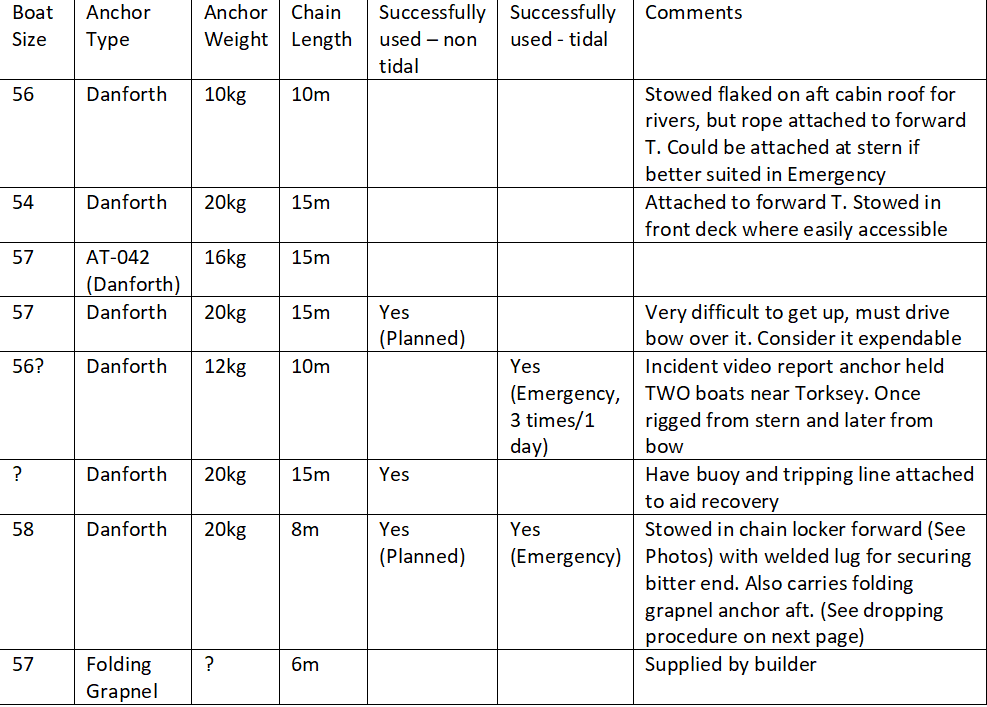
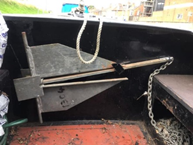
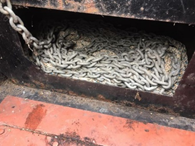
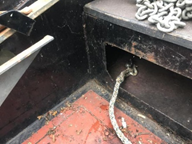
The contributors also commented on folk remembering to a have the anchor ready to use (Its attached??), and know HOW they will safely use the anchor in an emergency.
Also – the anchor CHAIN must be flat on riverbed for best holding power, ensure to use sufficient rope between boat and chain.
Cruisers
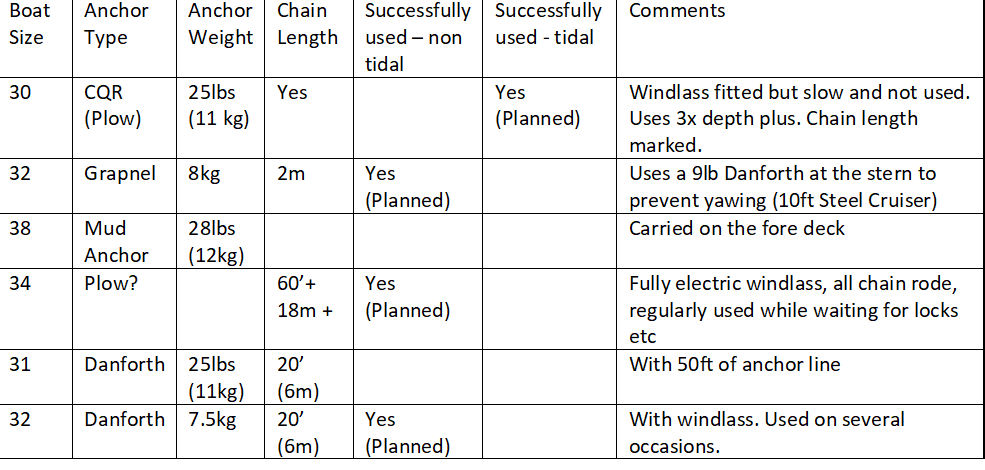


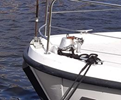
Anchoring Procedures:
Contribution 1 – Routine anchoring procedure – 32 ft Cruiser.
1. With a 2 person crew, 1 crew member takes the helm and motors slowly against the current to a stop and puts the gear in neutral.
2. The other crew member stands on the bow with the anchor.
3. With the rode secured to the boat slowly lower the 8kg Grapnel anchor over the bow as the boat starts to drift back. (The Danforth may be more appropriate in sand or mud as found on tidal section)
4. Let out (in this instance) 30 foot of rode and tie it off to a deck cleat.
5. The boat drifts back with the current (if not, slowly start to motor back) until the rode is taught indicating the anchor has gripped (set).
6. The River Soar tends to be about 6 to 7 feet deep away from the bankside, then add 3 foot for the bow height, say 10 foot in total. We have managed to anchor with about 30 foot of rode.
7. Turn the engine off and remove the key from the ignition.
8. Then anchor at the stern by slowly lowering the 4kg Danforth anchor to reduce the swinging of boat (tie it off to the port or starboard cleat), but allow some loose rode in case of any waves from passing boats or wind (A stern anchor can be dangerous if there is any chance of larger waves coming from astern and for this reason it is only a suitable technique to use in sheltered waters). Even then the boat will usually twist quite a bit (up to about 35 degrees).
9. Never have the engine running in gear when the stern anchor is in the water as the rode will get wrapped around the propeller.
10. Begin anchor watch. When the Grapnel anchor is firmly set, look around for reference points in relation to the boat such as a tree or a bush. Make regular checks (say every ½ hour) to make sure those reference points are in the same place in relation to your boat to make sure you’re not drifting. If the anchor is not holding you can let out more rode, or try re-anchoring (pull up the stern anchor first).
11. To retrieve your anchors. First pull up the stern anchor. Then retrieve the bow anchor by pulling at the anchor rode or if the anchor is gripping firmly, power forward very slowly while pulling up the rode, cleat the rode before it hangs vertically at the bow. As the boat moves slowly past the vertical this will use the movement of the boat to free the anchor and protect you from being dragged over the bow.
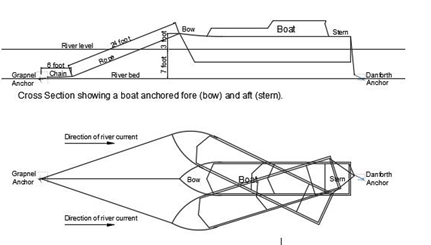
Contribution 2 – Routine and Emergency – 58ft Narrowboat
Mooring to an Anchor
We drop the front anchor first (Heading into the current) and let the boat move back until it has dug in, and then throw the back anchor as far as we can, tightening the rope enough to hold the boat in line. To get the anchors up, the grapnel usually comes up quite easily by pulling it, and then we move the boat forward over the danforth anchor to release it and I haul it up into the front deck. This can take a bit of effort especially if the anchor is well dug in. We usually tie the anchor rope onto the front T cleat before trying to get it up
We have done this a few times on non tidal rivers and it has worked well. We have an anchor light at the back which we leave on if mooring overnight. We generally use both anchors to keep the boat straight.
Using the anchor on the tidal Trent:
We had to anchor due to engine problems a few times on the same journey. The first time was at West Burton Power Station on the bend. I threw the front anchor over the side and Ian went into the engine bay. It was on an ebb tide, so I was ready with the boat pole to keep us a safe distance away from the encroaching sides, and when Ian had finished he almost set off in the wrong direction as he didn’t realise the boat had turned round with the current.
It wasn’t as dramatic as you might expect. I threw the anchor over the side of the boat that was closer to the middle of the river and then made sure I was out of the way of the chain and rope. My first reaction was that I was worried about what would happen to the boat, obviously as the engine stopped we just drifted with the flow. I did feel a bit anxious seeing the chain disappear beneath the boat initially, but then she quickly began to turn and the anchor was in front of us as we slowly drifted backwards. I don’t think we were going fast enough for it to cause a problem, even with the tide but she seemed to somehow stay in the middle of the channel and gently turn round and then stop as the anchor dug in.
Later we had to anchor again as we lost power about 10 minutes after passing West Stockwith Lock. We were bound for Keadby, and were advised to carry on with the tide, but ignoring this advice we turned around to make our way back to West Stockwith against the tide. We had to drop anchor three times before finally reaching the lock, and every time I pulled it up it seemed to get heavier. The first time I was careful not to damage our paintwork and it wasn’t too bad, the second time it came up with an estate agent’s sale board attached and I gave up caring about the paintwork, and the third time I no longer had the strength to haul it out of the water, so I had to steer the boat while Ian pulled it up.
We were in touch with the Lock Keeper at West Stockwith who stayed late in order to keep the lock open for us. One difficulty was trying to tell him how far away from his lock we were as there were no obvious landmarks in sight.
I would highly recommend testing your anchor before travelling on the tidal Trent, making sure that it is properly attached to the boat and easily accessible, and if you do need to use the anchor, make sure you are travelling in the right direction when you continue your journey!
Contribution 3 – from local boater
The helmsman has the equipment right in front of him and can change the rope shackled to his anchor very quickly to suit the circumstances, but has assumed the flow will be behind him on the river. This avoids real risk of injury to “crew” letting anchor go from cratch area?
Rubbish drawing, and the skipper concerned has never actually used the anchor on his boat! As it will take half the paint off, he hopes he never will! Strictly Emergency only!
Its a 15kg Danforth with 10m of chain!
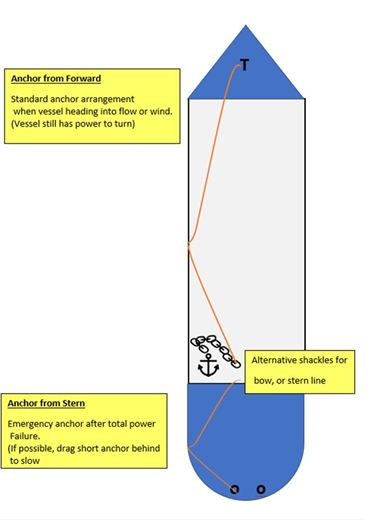
Contribution 4 – from Local Boater
“We did actually manage to stop two 57 feet narrowboat using one 12 kg Danforth, 10m chain and 10m line on a strong tide last summer.
We had to deploy after both boats lost power! Must admit, I was surprised but very glad it worked as we were drifting upstream bumping into the scenery as we went prior to deploying!!
We fed it in gradually and drifted with the flow until the slack was taken up, it dragged a short distance then it dug in but the spring in the line cushioned the process of stopping. Once stationary we drifted in the flow and wind like a pendulum around the anchor. I did have too much line the first time we dropped the anchor because we had previously carried it up the Tidal Severn where, due to the depth of water it’s recommended you have 20 metres of line plus 10 metres of chain.
I shortened it back for the second and third deployment!”
Contribution 5
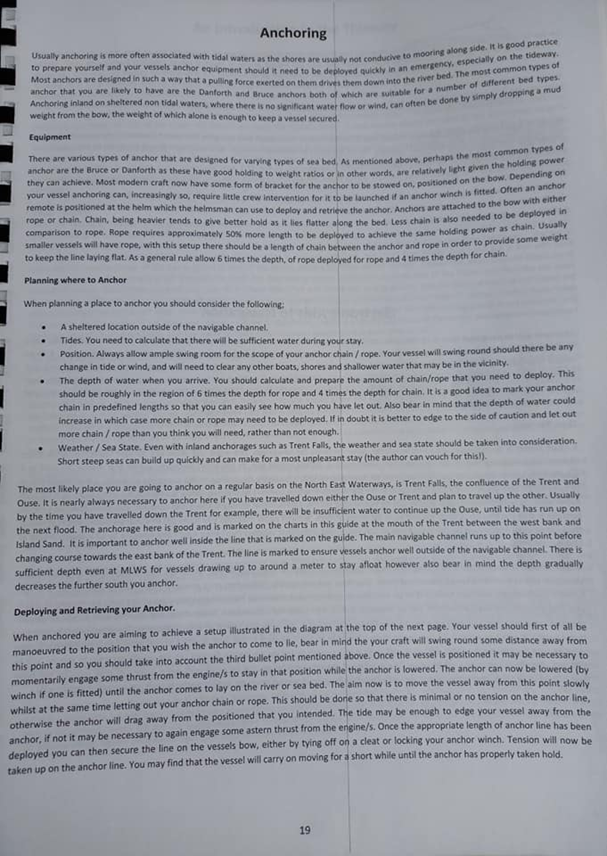
Summary of findings from local reports
Despite running a Post today on Trentlink, and running an extended post on the same subject a few months ago, we have received only 2 reports of folk using their anchors in an emergency from narrowboats (surely the most difficult to anchor as they usually have no fitted systems). Both cases had Danforth anchors with chain and rope and were correctly prepared for the river. Both anchored more than once with engine problems, so we seem to have a total of 4 or 5 anchor operations, including one from the stern (Hardly a convincing sample and over an indefinite time frame, but perhaps indicative that this is not something that happens very often?).
Encouragingly, there is NO report an excessive “snatch” loading as the weight came on the anchor equipment in any report. No damage to mooring equipment No “pulling the stern down”. Encouraging but not conclusive? (The Trent riverbed is I believe a mixture of gravel and mud. This potentially offers a Danforth anchor flukes some resistance but will perhaps not immediately “dig in hard” until the boat slows down. Accounts also indicate the rope section of the ground tackle has a strong “elastic” component, which along with the weight of the chain acts as something of a shock absorber.
Hardly conclusive…. But comforting? (I’d still like to hook up to a “Buddy Boat” instead!)
